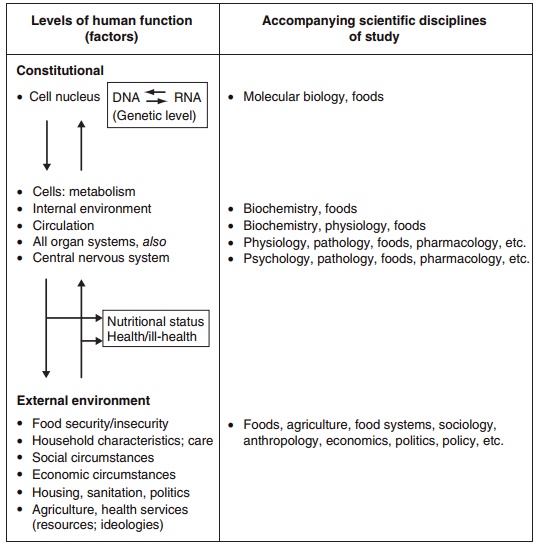Chapter: Introduction to Human Nutrition: A Global Perspective on Food and Nutrition
A conceptional framework for the study of nutrition
A conceptional framework for the
study of nutrition
In the journey of discovery into nutrition science it will often
be necessary to put new knowledge, or new applications of old knowledge, into
the perspective of the holistic picture. For this, a conceptual frame-work of
the multidisciplinary nature of nutrition science and practice may be of value.
Such a conceptual framework, illustrating the complex interactions between
internal or constitutional factors and exter-nal environmental factors which
determine nutritional status and health, is given in Figure 1.1.

Figure 1.1 Conceptual framework for a holistic, integrated understand-ing of human nutrition.
On a genetic level it is now accepted that nutrients dictate
phenotypic expression of an individual’s gen-otype by influencing the processes
of transcription, translation, or post-translational reactions. In other words,
nutrients can directly influence genetic (DNA) expression, determining the type
of RNA formed (transcription) and also the proteins synthesized (translation).
For example, glucose, a carbohydrate macronutrient, increases transcription for
the synthe-sis of glucokinase, the micronutrient iron increases translation for
the synthesis of ferritin, while vitamin K increases post-translational
carboxylation of glu-tamic acid residues for the synthesis of prothrombin.
Nutrients, therefore, influence the synthesis of struc-tural and functional
proteins, by influencing gene expression within cells.
Nutrients also act as substrates and
cofactors in all of the metabolic reactions in cells necessary for the growth
and maintenance of structure and function. Cells take up nutrients (through
complex mecha-nisms across cell membranes) from their immediate environment,
also known as the body’s internal envi-ronment. The composition of this
environment is carefully regulated to ensure optimal function and survival of
cells, a process known as homeostasis, which gave birth to a systems approach
in the study of nutrition.
Nutrients and oxygen are provided to
the internal environment by the circulating blood, which also removes metabolic
end-products and harmful sub-stances from this environment for excretion
through the skin, the kidneys, and the large bowel.
The concerted function of different
organs and systems of the body ensures that nutrients and oxygen are extracted
or taken up from the external environ-ment and transferred to the blood for
transport and delivery to the internal environment and cells. The digestive
system, for example, is responsible for the ingestion of food and beverages,
the breakdown (digestion and fermentation) of these for extraction of
nutrients, and the absorption of the nutrients into the circulation, while the
respiratory system extracts oxygen from the air. These functions are
coordinated and regulated by the endocrine and central nervous
The health or disease state of the
different organs and systems will determine the nutrient requirements of the body
as a whole.
The central nervous system is also
the site or “head-quarters” of the higher, mental functions related to
conscious or cognitive, spiritual, religious, and cultural behaviors, which
will determine, in response to the internal and external environments, what and
how much will be eaten. What and how much is eaten will further depend on what
is available, influenced by a host of factors determining food security. All of
these factors, on an individual, household, community, national, or international
level, shape the external environment.
During the first renaissance of nutrition, emphasis was placed
on the study of nutrients and their functions. A medical, natural science or
biological model underpinned the study of the relationships between nutrition
and health or ill-health. During the second renaissance, these aspects are not
neglected, but expanded to include the study of all other external
environmental factors that determine what and how much food and nutrients are
available on a global level. These studies are underpinned by social,
behavioral, economic, agricultural, and political sciences. The study of human
nutrition therefore seeks to understand the complexities of both social and
bio-logical factors on how individuals and populations maintain optimal
function and health, how the quality, quantity and balance of the food supply
are influenced, what happens to food after it is eaten, and the way that diet
affects health and well-being. This integrated approach has led to a better
understanding of the causes and consequences of malnutrition, and of the
relationship between nutrition and health.
Related Topics